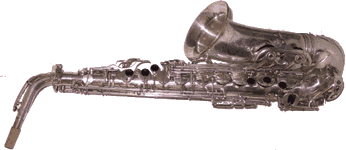For publications, click on the bouncing white ball below

Adolphe Sax 1814 - 1894
Sax was a Belgian, who invented the saxophone in 1840. He was musically trained at the Brussels Conservatory in flute and clarinet, and he studied instrument making with his father, Charles.

Adolphe Sax's family of saxophones, ca. 1860
From smallest to largest: Soprano, alto, tenor, baritone
1814 Adolphe Sax is born in Dinant, Belgium, where he studied instrument making with his father, Charles- Joseph (1791-1865).
1834 Adolphe Sax perfects bass clarinet design by improving keywork and construction.
1840 Saxophone invented by Adolphe Sax, in Paris. Originally called a saxhorn, since his goal was to create an instrument which was a hybrid possessing woodwind and brass elements.
1842 Saxs close friend Hector Berlioz writes an article in a Paris magazine describing Sax's newest invention.
1844 Berlioz conducts a concert featuring an arrangement of his choral work Chant Sacre, which includes saxophone.
1844 Saxophone exhibited for the first time at Paris Industrial Exhibition.
1845 Sax successfully re-tools military band arrangements by replacing oboe, bassoons, and french horns with saxophones in Bb and Eb, producing a more homogenous sound.
1846 Sax granted patent for saxophone
1853 Saxophone first played in the United States
1858 Sax becomes Professor of Saxophone at Paris Conservatory.
1866 Sax patent expires. Millereau Co. patents Saxophone-Millereau, which features a forked F# key
1868 Gautrot, Pierre Louis & Co. devises screw-in pad system and mechanism inside pad cup to keep outside of pad flat.
1870 Saxophones are used in bands of Gilmore and Sousa
1873 American bandleader Patrick Gilmore (1829-1892) uses the saxophone in military bands for the first time in New York City
1875 Goumas--patents saxophone with fingering system similar to the Boehm system, already in use for flute and clarinet.

Adolphe Sax Bass Saxophone, 1876
1879 Georges Bizet use the saxophone in his L'Arlesienne Suites No. 1 & 2
1881 Sax extends his original patent and lengthens bell to include low Bb and A. He also extends the range upward to F# and G, with the use of a fourth octave key
1885 The first saxophone is built in the U.S. by Gus Buescher. Other early makers include Holton, Martin, and White.
1886 Association Des Ouvriers devises right hand C trill key, and a half-tone system for first fingers of left and right hands.
1887 Association Des Ouvriers invents tuning ring, and the precursor of an articulated G# key. Evette and Schaeffer improve on articulated G# key so that G key can be held down while any finger of the right hand is being used They also improved the forked F#.
1888 Lecomte invents the single octave key, and rollers for low Eb-C
1890 The first known recordings of the saxophone.
1894 Adolphe Sax dies.
1916 Charles Ives writes a saxophone part in Symphony No. 4.
1917 Benjamin Vereecken's Foundation of Saxophone Playing is published by Carl Fischer. It is still in print.
1920 Saxophones sells extremely well, soon to be the major jazz woodwind, although the clarinet would still be more prominent through the dixieland and swing eras. School bands begin to form, using saxophones.
1922 The Selmer Model 22 is
introduced, using a forged key mechanism.

Selmer model 22
1926 Selmer makes the Model 26, known as the "Pea Shooter" due to the small bore.
1927 Ravel uses saxophones in his Bolero.
1929 Sigrfid Karg-Elert (1877-1933) composes 25 Caprices for Saxophone.
1930 Selmer acquires Adolphe Sax company.
1931 Selmer produces the Cigar Cutter, so named for the flat plate with the hole, reminiscent of a cigar tip cutter.

Selmer C melody cigar-cutter, ca. 1930
1933 Selmer's octave mechanism is changed.
1935 Selmer saxophones offer many mechanical changes, and the bell keys are put on the right side of the bell. Also, the action is balanced.

Selmer balanced action alto saxophone, 1939
1939 Jazz saxophonist Arnold Brillhart begins design and production of mouthpieces.
1939 Paul Hindemith composes a Sonata for alto saxophone and piano.
1941 Top Tones, by Sigurd Rascher is released as a supplemental study of fingerings and tone production of the saxophone's altissimo register, almost doubling the range of the instrument.
1943 Berbiguer's 18 Exercises is published by Marcel Mule.
1947 Selmer makes the Super action Sax, another transitional model, with some changes in key leverages, but otherwise similar to the balanced action model.
1954 The Selmer Mark VI Saxophone begins to be produced, with greater refinement of the mechanism, and many tuning improvements.
1975 With the Mark VII, the bore and taper are changed to facilitate production of the altissimo register. Minor intonation improvements .
1976 Standard high F# key added to Mark VII.

Selmer Mark VII
1976 Selmer's square-chamber mouthpieces marketed.
1980 Yamaha introduces 62 series.
1981 Selmer S80 introduced.
1981 Super Action 80.
1986 Selmer S80 Series II introduced.
1987 The Super Action Series II, with front "x" key more like clarinet A key, and a bent high F# key.
1989 The Super Action Series IIa, with left hand little finger keys.
Email comments and questions to: